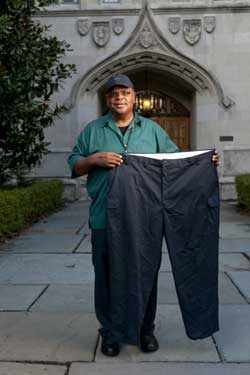Taking Stairs To Lose Weight, Get Fit
LIVE FOR LIFE program helps employee lose 80 pounds with stair-climbing program

Gregory Minor kept a steady pace as he climbed the sixth floor and up the last set of stairs in the Davison Building. He reached the top, took a deep breath, grabbed the handrail and headed down.
Read MoreNearly 130 steps later, he stood in the basement, where he began the workout fifteen minutes earlier.
"I see my results, and it makes me feel good," said Minor, a housekeeper at Duke University Medical Center.
By climbing stairs at least twice a day through a program with LIVE FOR LIFE, Duke's employee wellness program, Minor lost 80 pounds in 18 months. He swapped 52-inch pants and 5x shirts for 42-inch pants and 2x shirts.
This month, LIVE FOR LIFE, launches "Take The Stairs," which encourages participants to track the number of stairs they climb each day - either up or down. As participants reach certain pre-defined goals, from the equivalent of a mile to a marathon, they turn in their log sheets for prizes. The year-round, start-any-time program replaces StairWELL to Health.
Liz Grabosky, LIVE FOR LIFE fitness manager, said the benefits of stair climbing include increased strength and bone density, lower risk of cardiovascular disease and weight loss when coupled with a healthy diet. According to the American Council on Exercise, stair climbing burns more calories per minute than jogging or cycling at a moderate pace on level ground.
"It is a great way to build physical activity into everyday living without having to purchase any special equipment," Grabosky said.
Minor, the housekeeper, started stair climbing after his doctor gave him a stern warning that his weight had raised his risk for diabetes and high blood pressure. He visited LIVE FOR LIFE for tips on how to incorporate more exercise into his lifestyle. "LIVE FOR LIFE told me walking steps would help burn calories and take the weight off," Minor said. "I didn't want to have to give myself insulin."
Staff and faculty can register for Take The Stairs online or in person at the LIVE FOR LIFE office on the lower level of Duke Clinic (Duke South) in the Red Zone. Once registered, participants receive an electronic or paper log sheet that outlines program levels.
To help participants understand how stair steps add up, the levels are based on the equivalent distance one might train to walk or run. "You start with a mile and work toward a marathon," Grabosky said.
Each level has a different prize, ranging from 40 LIVE FOR LIFE dollars for the one-mile level (2,000 steps) to a LIVE FOR LIFE lunch bag for the marathon level (52,400 steps). For individuals who want help in setting exercise goals, LIVE FOR LIFE also provides workout plans that map out an increase in the number of steps walked each week so that the one-mile level is completed in one month, and the marathon level in six months.
Minor has set a personal goal of continuing to climb up and down the 127 steps in the Davison Building each day until he can tighten his belt another four inches.
"From 52 down to 38. That would be a big change, but I know I can do it," he said. "If people started taking the steps instead of the elevator, they'd be surprised at what can happen."